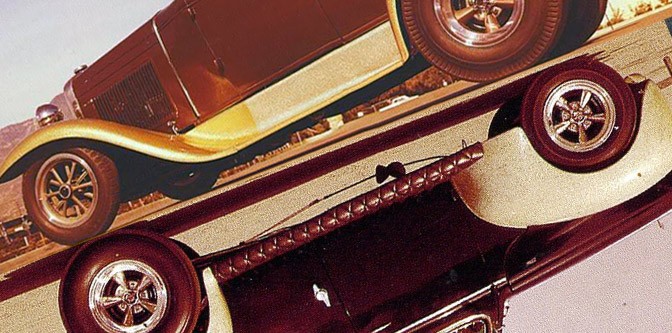The Swingin’ Stances of San Bernardino

As the ‘60s progressed, the popularity of the nose-up look was rising. Everything from tube axles to wooden blocks hoisted front ends towards the sky. Whether it was for performance or drive-in appeal, the style spread from the strip to the street in a hurry. Some cars led, some cars followed and some took a stance in the opposite direction.
John Davies’ and Jim Head’s prewar Fords represent the quintessential hot rod rake — mid-‘60s style. Aesthetically, John’s coupe was nothing short of radical. Starting with a 1930 ‘A’ body, he chopped the top 5½ inches. By retaining the stock fenders and hood, he successfully emphasized the car’s focal point — the rolling stock. Up front, he slid a pair of magnesium American Racing 12-spokes to the 4½-inch dropped axle. Thanks to some 3.80 x 15 Michelin rubber, the stock front bumper sat inches from the asphalt. The rear, on the other hand, was ready to pounce with its five spoke Americans and Englewood piecrust slicks. Power was transferred through a chromed Pontiac rear end equipped with Chevrolet coil springs, traction bars and a much-needed anti-roll bar.
Both the roof insert and interior of the earth toned ‘A’ were treated to narrow pleats by Tom’s Top Shop. From the dashboard to the center console, the San Bernardino shop spared no expense stitching up the ‘60s flair. A Moon pedal and large chrome tach help round out the competition-flavored coupe.
Two years after John’s coupe hit the streets, Jim Head followed suit with a rod of his own. Except his was based on a 1940 Ford panel delivery. Other than a mild shave, the bodywork remained stock. Rather than going the high-riding route, Jim installed a 2½ inch dropped axle to bring the front end down to earth. The rear was raised by a Model ‘T’ spring to clear the Halibrand quickchange and meaty Mickey Thompson slicks. Unlike John’s raw rolling stock, Jim opted for fully polished Americans.
Inside, the panel was just as far-out as the ‘A.’ Black diamond-tuft naugahyde upholstery covered the interior and spanned out onto the running boards. According to Jim, the seat was patterned after a church pew.
Despite their differing body styles, these two San Bernardino-based hot rods have more than their killer stances in common. John’s ‘A’ featured a metallic brown body with coarse gold metalflake fenders. Jim’s ’40 also received a two tone treatement, except the body was candy sapphire green and the fenders were a lighter metalflake with spider webbing. Additionally, both machines ran dressed up, but mostly stock, GM mills — a Chevy and Olds respectively. This hinted that the cars were made to be thrashed on.
Ever since I saw Bob Wagner’s color shots of this pair in Thom Taylor’s 50 Years of Rod & Custom, I have wondered about the connection between the two machines. Maybe John and Jim were pals?
Either way, these two Fords commanded attention. So the question is: which one would you rather pilot when the light turns green?
-Joey Ukrop
Photos by Bob Wagner, Rod & Custom July 1965 and January 1967. Color photos from the H.A.M.B., The Rodder’s Journal and 50 Years of Rod And Custom.


















